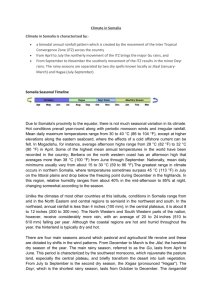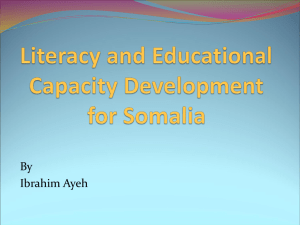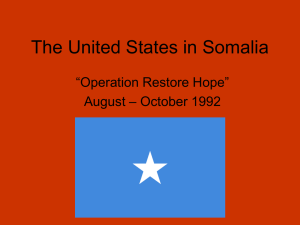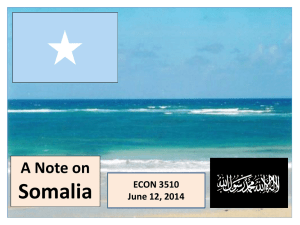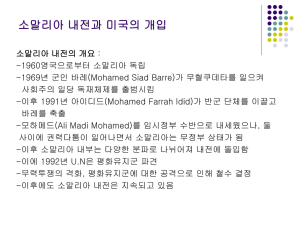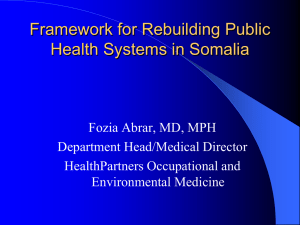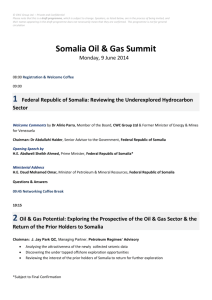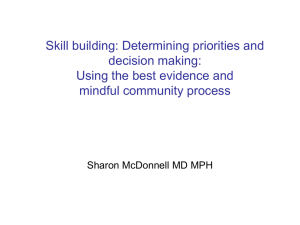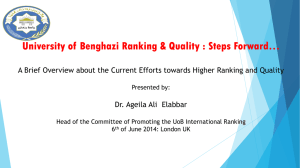Somalia After State Collapse: Chaos or Improvement?
advertisement
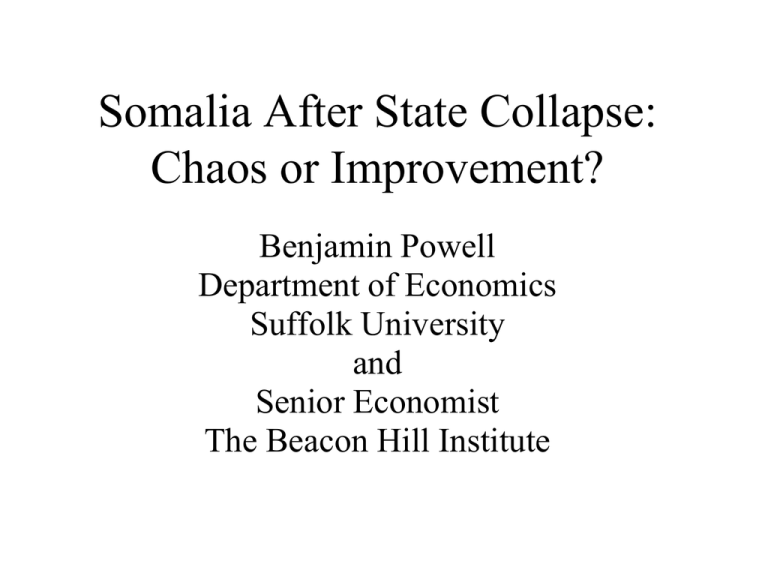
Somalia After State Collapse: Chaos or Improvement? Benjamin Powell Department of Economics Suffolk University and Senior Economist The Beacon Hill Institute Background • Government Collapse in 1991 • 1993-1995 UN/US Humanitarian Interventions • Governments in Exile • Breakaway ‘States’ of Somaliland and Puntland Competing Theories • Hobbes/Buchanan/Olson • Rothbard/Friedman • Comparative Institutional Perspective Government Failure • 1969-1991 Dictatorship – Scientific Socialism – Land Nationalization and Redistribution – Population Relocation • Public Goods? – 1988-1989: 90% of all Govt spending was on defense and administration – Spending on ‘social services’ less than 1% GDP – Rural Pastoral Sector produced 65% of GDP from 1974-1988 but received less than 6% of Govt Spending • Informal/Black Market – Employed 70% of labor by mid 80s – banking, finance, dispute settlement, health, education Three Distinct Periods • Post 1991 Warring – US/UN Interventions 1993-1995 • 1995-2006 • 2006-Pres. Rural Pastoral Sector • Boom in Livestock Trade – In Garrissa Export Market the value of cattle sales increased 400% from 1991 to 1998 while volume quadrupled from 1989-1998 – In the north ports of Bossaso and Berbera exported 95% of all goats and 52% of all sheep in East Africa. Larger volume in 1999 than anytime under a government. • Drought 1999-2000 – Did better than neighboring Kenya and similar to other East African Nations • Security – Armed Security costs $0.01/km per animal – In 1999 Only 26 percent of traders identified security as a problem and only 13 percent thought it was more of a problem than in 1990 Urban/Commercial Activity • Major Companies – Dole Fruit, Coca-Cola, DHL. – GM, BBC, British Airways • City of Borama – 150-300K Population – 95 Tea Shops, 90 Restaurants (8 with star ratings), 145 Elementary Shops, 69 Wholesalers, 106 Retail shops, 30 pharmacies, 16 hotels (4), 18 Fuel Stations (7), Airport (1), 2 hospitals, and a University with 100,000 books Overall Living Standards • Compared to Itself – Leeson (2006) 18 Indicators 1985-1990 to 2000-2005 – Finds 13 Improved, 2 Worse, 3 Questionable • Relative to 42 other Sub-Saharan Countries Table 1. Somalian Living Standards 2005 Death Rate (per 1000) Infant Mortality (per 1000) Life Expectancy Child Malnutrition (% of children underweight) Telephone-Main Lines per 1,000 people Mobile Cellular Phones per 1,000 people Internet Users Per 1,000 People Households with TV (% households) Immunization, DPT (% children 12-23 months) Immunization, measles (% children 12-23 months) Improved sanitation facilities (% of pop with access) Improved water source (% of pop with access) Tuberculosis (per 100,000 people) 17 133 47 26 25 63 25 8 30 40 26 29 411 Rank Among 42 Sub-Saharan Countries 2005 1990 1985 17 38 18 a 20 8 16 11 27 c 41 42 24 41 31 Data from closest year preceeding listed date was used when data for given year was unavailable Italics indicate a tie for the given rank with at least one other country. a. ranking out of 36 b. ranking out of 41 c. ranking out of 40 d. ranking out of 39 e. ranking out of 37 f. ranking out of 36 37 32b 37 29 30 31 34 b 33 d 21 19 f 38 38d 40 b e Table 2. Somalia's Rank Among Peaceful Sub-Saharan Nations Death Rate (per 1000) Infant Mortality (per 1000) Life Expectancy Child Malnutrition (% of children underweight) Telephone-Main Lines per 1,000 people Mobile Cellular Phones per 1,000 people Internet Users Per 1,000 People Households with TV (% households) Immunization, DPT (% children 12-23 months) Immunization, measles (% children 12-23 months) Improved sanitation facilities (% of pop with access) Improved water source (% of pop with access) Tuberculosis (per 100,000 people) 2005 1990 1985 8 17 9 12 6 10 6 a 12 17 16 15 18 12 17 15 17 14 14 16 15 16 17 17 11 10 18 Data from closest year preceeding listed date was used when data for given year was unavailable All Rankings out of 18 (17 peaceful nations plus Somalia) unless otherwise noted Italics indicate a tie for the given rank with at least one other country. a. ranking out of 17 Table 3. 1990-2005 Percent Improvement Compared to Nations That Warred at a Similar Time Death Rate (per 1000) Infant Mortality (per 1000) Life Expectancy Telephone-Main Lines (per 1,000 people) Immunization, DPT (% children 12-23 months) Immunization, measles (% children 12-23 months) Tuberculosis (per 100,000 people) Somalia 5 Country Avg 22.7% 0.0% 11.9% 1150.0% 57.9% 33.3% -20.5% 12.6% 12.7% 3.7% 271.3% 46.2% 24.2% -11.1% Five Country Avg Comprised of Djibouti (91-94), Mali (90-96), Mauritania (89-91), Senegal (89-91), and Togo (91-92) Complex Goods and Services • Airline Travel – 15 Firms 60 Planes 6 International Routes • Up From 1 National Carrier and 1 Route in 1989 • Banking/Funds Transfers – Hawala System moves $0.5-1 billion annually – SOS/$ • Roads – 3,000 KM per 1k pop = Neighboring Govts. • Social Insurance ‘Public Goods’ • Security/Protection – Privately hired • “Taxes payable to a tentative local authority or strongman are seldom more than 5%, security is another 5%...” Economist 12/05 • Little shows that rural security costs have not increased • Law – Clan based elder dispute resolution – common law of Xeer and Diya payment system – Muslim courts • National Defense... What About Pirates? • Somalia does fairly well in a comparative institutional analysis • It succeeds in providing some law and order without a government • Given ideology, culture, and resources, Somalia is performing better than when it had a state and equal or better than many other African countries with governments. Implications for Africa • Customary law is not unique to Somalia • Need to distinguish between “modern” Africa and traditional Africa • Much effort is made to prop up “modern” Moving Forward • “The rogue African state should be left to the fate it deserves – implosion and state collapse.” George Ayittey, MPNR 173. • Line up informal and formal • Evolve customary law • What “we” can do
